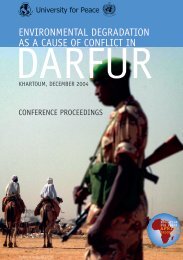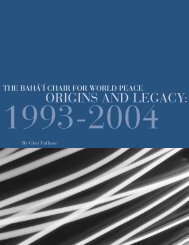who medicines strategy - libdoc.who.int - World Health Organization
who medicines strategy - libdoc.who.int - World Health Organization
who medicines strategy - libdoc.who.int - World Health Organization
Create successful ePaper yourself
Turn your PDF publications into a flip-book with our unique Google optimized e-Paper software.
WHO MEDICINES STRATEGY 2004-2007 | 116EO 7.2Essential <strong>medicines</strong> list, clinicalguidelines, and formulary processdeveloped and promotedRationaleThe selection of a list of <strong>medicines</strong>, based on anumber of criteria including disease pattern andrecommended treatments, is the foundation of theessential <strong>medicines</strong> concept 58 . Clinical guidelinesindicate the most cost-effective therapeuticapproach, on the basis of valid clinical evidence.Their impact is greatest if the end-users,prescribers and, to a certain extent, patients areclosely involved in developing the guidelines.Formularies are commonly publications thatcombine the list of <strong>medicines</strong> with conciseguidance on their safe and rational use. Evidencefrom practice and research has demonstrated thatthe most cost-effective use of <strong>medicines</strong> may vary— depending on factors such as local marketprices, availability, and distribution costs — andthere is a need to support countries in developingor updating their rational use publications.ProgressThe WHO Model List of Essential Medicineshas been regularly revised and proved tobe a valuable tool over the past 25 years,complemented and enhanced by the publicationin 2002 of the WHO Model Formulary 59 .Collaboration within WHO has resulted in aformulary that incorporates updates in treatmentprotocols from the disease-specific departments inWHO. Access is available via the WHO EssentialMedicines Library on the WHO website 60 .The Library links essential <strong>medicines</strong> to WHOtreatment guidelines, the Model Formulary, priceinformation, pharmacopoeal monographs, andother WHO sites including information on adversedrug reactions and the ATC/DDD classification(Figure 24). There are now 135 countries withnational standard treatment guidelines and 156countries with national essential <strong>medicines</strong> lists,of which about 75% have been updated with<strong>int</strong>he last five years.Figure 26: The WHO Essential Medicines Library (http://mednet3.<strong>who</strong>.<strong>int</strong>/eml/)Clinical guidelineSummary of Clinical GuidelineEvidence:Reasons for inclusionSystematic reviewsKey referencesWHOMODELLISTWHO Model FormularyCost:per unitper treatmentper monthper case preventedQuality information:Basic quality testsInternational PharmacopoeiaReference standards











